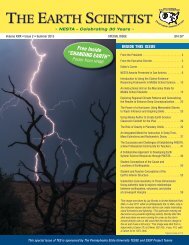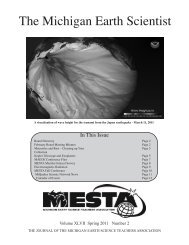The Earth Scientist
The earTh ScienTiST - NESTA
The earTh ScienTiST - NESTA
You also want an ePaper? Increase the reach of your titles
YUMPU automatically turns print PDFs into web optimized ePapers that Google loves.
Page 32<br />
<strong>The</strong> <strong>Earth</strong> <strong>Scientist</strong><br />
References<br />
Aikenhead, G.S. & Jegede, O.J. (1999). Cross-cultural science education: a cognitive explanation of a cultural<br />
phenomenon. Journal of Research in Science Teaching, 36, 269-287.<br />
American Association for the Advancement of Science (AAAS). (1993). Benchmarks for Science Literacy. New<br />
York: Oxford University Press. http://www.project2061.org/publications/bsl/online/bolintro.htm<br />
Asghar, A.A., & Libarkin, J.C. (2010). Gravity, magnetism, and “down”: Non-physics college students’<br />
conceptions of gravity. <strong>The</strong> Science Educator, 19, 42-55.<br />
Blake, A. (2004). Helping young children to see what is relevant and why: supporting cognitive change in <strong>Earth</strong><br />
science using analogy. International Journal of Science Education, 26, 1855-1873.<br />
Dove, J.E. (1998). Students’ alternative conceptions in <strong>Earth</strong> science: a review of research and implications for<br />
teaching and learning. Research Papers in Education, 13, 183-202.<br />
Cheek, K.A. (2010). Commentary: A Summary and Analysis of Twenty-Seven Years of Geoscience Conceptions<br />
Research. Journal of Geoscience Education, 58, 122-134.<br />
diSessa, A. A. (2006). A history of conceptual change research: Threads and fault lines. In K. Sawyer (Ed.),<br />
Cambridge handbook of the learning sciences (pp. 265 – 282). Cambridge, England: Cambridge University<br />
Press.<br />
Gobert, J. (2000). A typology of causal models for plate tectonics: inferential power and barriers to<br />
understanding. International Journal of Science Education, 22, 937-977.<br />
Kavanagh, C., Agan, L., & Sneider, C. (2005). Learning about phases of the Moon and eclipses: A guide for<br />
teachers and curriculum developers. Astronomy Education Review, 4, 19-52.<br />
King, C. (2008). Geoscience Education: an overview. Studies in Science Education, 44, 187 – 222.<br />
King, C. (1992). <strong>The</strong> secrets of Plasticine balls and the structure of the <strong>Earth</strong>: Investigation through discussion.<br />
Physics Education, 37, 485-491.<br />
Libarkin, J.C., & Stokes, A., in press, <strong>The</strong> Moon Has No Gravity: Examples of Idea Mixing in Explanations of<br />
Physical Processes, Planet.<br />
Marques, L., & Thompson, D. (1997). Portuguese students’<br />
understanding at ages 10-11 and 14-15 of the origin and nature<br />
of the <strong>Earth</strong> and the development of life. Research in Science &<br />
Technological Education, 15, 2-22.<br />
Rakkapao, S., Arayathanitkul, K., & Pananont, P. (2009). Thai<br />
university student’s prior knowledge about P-wave generated<br />
particle motion. Journal of Geoscience Education, 57, 213-226.<br />
Sibley, D. (2005). Visual abilities and misconceptions about plate<br />
tectonics. Journal of Geoscience Education, 53, 471-477.<br />
Strike, K. A., & Posner, G. J. (1992). A revisionist theory of<br />
conceptual change. In R. Duschl & R. Hamilton (Eds.),<br />
Philosophy of Science, Cognitive Psychology, and Educational<br />
<strong>The</strong>ory and Practice (pp. 147-176). Albany, NY: SUNY.<br />
Your one-stop shop for marine<br />
science curriculum supplies.<br />
www.LeaveOnlyBubbles.com<br />
715-659-5427<br />
support@leaveonlybubbles.com<br />
Leave Only Bubbles is a subsidiary of “What If…?” Scientific, a teacherowned<br />
and operated earth science supply company founded in 1997.<br />
About the Authors<br />
Julie Libarkin (libarkin@msu.edu) is an Associate Professor<br />
of Geological Sciences and Science and Mathematics<br />
Education at Michigan State University, Department of<br />
Geological Sciences, 206 Natural Science, East Lansing,<br />
MI 48824.<br />
Emily Geraghty Ward (wardem@msu.edu) is a Research<br />
Associate in Geological Sciences and <strong>The</strong> Center for<br />
Research on College Science Teaching and Learning<br />
at Michigan State University, Department of Geological<br />
Sciences, 206 Natural Science, East Lansing, MI 48824 USA.<br />
© 2011 National <strong>Earth</strong> Science Teachers Association. All Rights Reserved.






